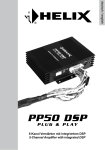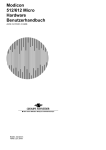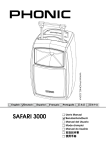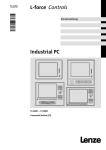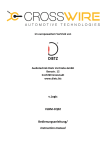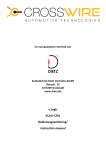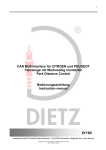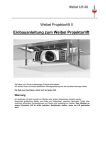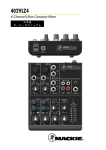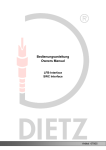Download PP 82DSP - Billiger.de
Transcript
deutsch / english PP 82DSP P LU G & P L AY 8-Kanal Verstärker mit integriertem DSP 8-Channel Amplifier with integrated DSP Herzlichen Glückwunsch! Sehr geehrter Kunde, wir gratulieren Ihnen zum Kauf dieses hochwertigen MATCH Verstärkers mit integriertem DSP. MATCH setzt mit der PP 82DSP neue Maßstäbe im aufstrebenden Plug & Play Markt. Dabei profitieren Sie als Kunde direkt von unserer nahezu 30 jährigen Erfahrung in der Forschung und Entwicklung von Audiokomponenten. Dieser Plug & Play Verstärker wurde von uns nach neuesten technischen Erkenntnissen entwickelt und zeichnet sich durch hervorragende Verarbeitung und eine überzeugende Anwendung ausgereifter Technologien aus. Viel Freude an diesem Produkt wünscht Ihnen das Team von AUDIOTEC FISCHER Allgemeine Hinweise Allgemeines zum Einbau von MATCH-Komponenten ten Sie bitte darauf, dass sich solche Teile auch in der doppelten Wandverkleidung verbergen können. Um alle Möglichkeiten des Produktes optimal ausschöpfen zu können, lesen Sie bitte sorgfältig die nachfolgenden Installationshinweise. Wir garantieren, dass jedes Gerät vor Versand auf seinen einwandfreien Zustand überprüft wurde. Allgemeines zum Anschluss des PP 82DSP Verstärkers Vor Beginn der Installation unterbrechen Sie den Minusanschluss der Autobatterie. Wir empfehlen Ihnen, die Installation von einem Einbauspezialisten vornehmen zu lassen, da der Nachweis eines fachgerechten Einbaus und Anschlusses des Gerätes Voraussetzung für die Garantieleistungen sind. Installieren Sie Ihren PP 82DSP Verstärker an einer trockenen Stelle im Auto und vergewissern Sie sich, dass der Verstärker am Montageort genügend Kühlung erhält. Montieren Sie das Gerät nicht in zu kleine, abgeschlossene Gehäuse ohne Luftzirkulation oder in der Nähe von wärmeabstrahlenden Teilen oder elektronischen Steuerungen des Fahrzeuges. Im Sinne der Unfallsicherheit muss der Verstärker professionell befestigt werden. Dieses geschieht über Schrauben, die in eine Montagefläche eingeschraubt werden, die wiederum genügend Halt bieten muss. Bevor Sie die Schrauben im Montagefeld befestigen, vergewissern Sie sich, dass keine elektrischen Kabel und Komponenten, hydraulische Bremsleitungen, der Benzintank etc. dahinter verborgen sind. Diese könnten sonst beschädigt werden. Ach2 Der PP 82DSP Verstärker darf nur in Kraftfahrzeuge eingebaut werden, die den 12V-Minuspol an Masse haben. Bei anderen Systemen kann der MATCH PP 82DSP und die elektrische Anlage des Kfz beschädigt werden. Verwenden Sie zur Verbindung des MATCH PP 82DSP mit dem Autoradio ausschließlich das beiliegende MATCH-Anschlusskabel! Die Verwendung eines anderen Kabels kann zu Schäden an ihrer Anlage führen. Die Sicherungen im Verstärker dürfen nur mit den gleichen Werten (2 x 25A) ersetzt werden, um eine Beschädigung des Gerätes zu verhindern. Höhere Werte können zu gefährlichen Folgeschäden führen. Die Kabelverbindungen müssen so verlegt sein, dass keine Klemm-, Quetsch- oder Bruchgefahr besteht. Bei scharfen Kanten (Blechdurchführungen) müssen alle Kabel gegen Durchscheuern gepolstert sein. Ferner darf das Versorgungskabel niemals mit Zuleitungen zu Vorrichtungen des Kfz (Lüftermotoren, Brandkontrollmodulen, Benzinleitungen etc.) verlegt werden. Anschluss- und Bedienelemente 1 2 3 4 1 Output Channels E - H Anschluss für die Lautsprecher der Kanäle E - H oder alternativ einen passiven MATCH PP Subwoofer. 2 Line Output Vorverstärkerausgänge zum Anschluss weiterer Verstärker. Zur Einschaltung weiterer Verstärker muss der Remote Ausgang (Rem Out) verwendet werden. 3 Optical Input Optischer Eingang im SPDIF-Format für digitale Stereosignale 6 7 8 9 10 5 4 AUX Input 3,5 mm Klinkenbuchse zum Anschluss externer Signalquellen. Dieser Eingang kann sowohl automatisch als auch manuell aktiviert werden. 5 System Connector Anschluss für das MATCH Anschlusskabel. Verwenden Sie ausschließlich das OriginalAnschlusskabel, um die PP 82DSP mit dem Autoradio zu verbinden. 11 12 13 14 15 6 Fuse LED zur Anzeige einer defekten Sicherung im Gerät. 11 Control Input Multifunktionsanschluss - dient zum Anschluss der URC 2A und weiterem Zubehör 7 +12V Anschluss für das Versorgungsspannungskabel +12V der Batterie. 12 USB Eingang Dient zum Anschluss an den Computer. 8 Rem Out Der Remote Ausgang dient zum Einschalten weiterer Verstärker. Dieser Ausgang muss bei Verwendung der LineOut Cinch-Ausgänge genutzt werden 13 Status LED Die Status LED zeigt den Betriebszustand und den ausgewählten Speicherbereich an. 14 Control Taster Dient zum Umschalten der Sound Setups oder zum Resetten des Gerätes 15 MicroSD Kartenleser Kartenleser zum Aufspielen von kompletten DSP-Setups 9 GND Anschluss des Massekabels (Minuspol der Batterie oder Fahrzeugchassis. 10 MODE Switch / DIP Switch Dienen zur Lautstärkeanpassung und zur Konfiguration der Fernbedienung 3 Inbetriebnahme und Funktionen 1 Output Channels E - H An diesen Ausgang kann entweder ein MATCH Subwoofer direkt angeschlossen werden, wobei dann vier der acht Kanäle der PP 82DSP dafür verwendet werden und an allen Ausgängen ein identisches Signal anliegen sollte. Alternativ kann jeder Kanal auch über die PC-Tool Software einzeln für andere Anwendungszwecke konfiguriert werden (z.B. als Center-Speaker etc.). Für den Anschluss anderer Lautsprecher liegt ein Kabel mit offenen Enden bei. 2 Line Outputs Die Line Outputs G und H sind spezielle Signalausgänge, die durch den „Balanced Dual Audio Transformer“ von der Eingangsmasse getrennt sind. Dadurch können keine Störgeräusche aufgrund von Masseverschleifungen auftreten. Diese Ausgänge liefern eine maximale Ausgangsspannung von 3 Volt RMS. Wenn Sie diese Ausgänge verwenden, ist es zwingend erforderlich, den Remote Ausgang zum Einschalten des/der Verstärker/s zu verwenden, da ansonsten Störsignale auftreten können. Der Remote Ausgang schaltet sich automatisch während des Power Save Modus sowie bei einem Software-Update ab. Wichtig: An den Line Outputs G und H liegt das gleiche Audiosignal wie an den Lautsprecherausgängen G und H an. Veränderungen in der PC-Tool Software an diesen Kanälen wirken sich also gleichermaßen auf die Lautsprecher- wie auch auf die Line-Ausgänge aus. 3 Optical Input Optischer Eingang im SPDIF-Format für den Anschluss an Signalquellen mit digitalem Ausgang.Die „Sampling Rate“ dieses Eingangs muss zwischen 6 - 192 kHz liegen. Das Eingangssignal wird automatisch an die interne Abtastrate angepasst. Um diesen Eingang aktivieren und in der Lautstärke regeln zu können, ist die optional erhältliche Fernbedienung URC 2A erforderlich. Hinweis: Es können ausschließlich Stereosignale und keine Dolby-codierten Daten verarbeitet werden! 4 AUX Input Dieser Anschluss dient als Signaleingang für MP3Player, Navigationsgeräte, etc. 4 Die PP 82DSP ist ab Werk so konfiguriert, dass sie bei Erkennung eines Musiksignals am AUX-Eingang diesen automatisch aktiviert. Sollte für mehr als 2 Sekunden kein Signal anliegen, schaltet die PP 82DSP automatisch wieder auf das Radiosignal um. Wenn MODE Switch Nr. 5 aktiviert ist, dann wird die automatische Aktivierung des AUX Eingangs deaktiviert und der AUX Eingang lässt sich manuell über die optional erhältliche Fernbedienung ein- und ausschalten. 5 System Connector Diese Buchse dient zum Anschluss des mitgelieferten Kabelbaums. Verwenden Sie zur Verbindung der MATCH PP 82DSP mit dem Originalradio ausschließlich diesen Kabelbaum. Achtung: Die Verwendung anderer oder ähnlicher Kabelbäume kann zur Zerstörung des Verstärkers, des Autoradios oder der angeschlossenen Lautsprecher führen. In jedem Fall führt dies zum Erlöschen der Garantie. Wichtiger Hinweis: Über diesen Anschluss wird die PP 82DSP nicht mit Spannung versorgt. Es ist daher zwingend erforderlich, dafür die nachfolgend mit (7) und (9) gekennzeichneten Klemmen zu verwenden. 6 Fuse Sollten die Sicherungen im Inneren des Gerätes durch eine Fehlfunktion zerstört werden, wird dieses durch das Aufleuchten der roten LED angezeigt. Bei normalem Betrieb bleibt die LED erloschen. 7 +12V Das +12V-Versorgungskabel ist am Pluspol der Batterie anzuschließen. Empfohlener Querschnitt: min. 10 mm². 8 Rem Out Dieser Ausgang dient dazu, weitere Verstärker einzuschalten. Verwenden Sie in jedem Fall diesen Ausgang, wenn Sie weitere Verstärker an die Line Outputs der PP 82DSP anschließen, da es ansonsten zu Störgeräuschen kommen kann. Dieser Ausgang aktiviert sich automatisch, sobald der Bootvorgang des DSP abgeschlossen ist. Zudem wird dieser Ausgang bei Aktivierung des „Power Save Modes“ und bei Betriebssoftware-Updates abgeschaltet. 9 GND Das Massekabel sollte am zentralen Massepunkt (dieser befindet sich dort wo der Minuspol der Batterie zum Metallchassis des Kfz geerdet ist) oder an einer blanken, von Lackresten befreiten Stelle des Kfz-Chassis angeschlossen werden. 10 MODE Switches / DIP Schalter Die sechs einzelnen MODE Switches dienen zur Anpassung der Lautstärke und zur Konfiguration der Fernbedienung, wenn deren Funktion nicht über die PC-Tool Software definiert wird. MODE Switch 1 und 2 dienen zur Lautstärkeanpassung aller acht Ausgangskanäle! MODE Switch 3 und 4 dienen zur Lautstärkeanpassung aller Kanäle, die als Subwooferausgang definiert wurden. MODE Switch 5 legt die Funktion des Mode Schalters auf der Fernbedienung fest. MODE Switch 6 aktiviert die Funktionen der Fernbedienung. 11 Control Input Dieser Multifunktionsanschluss dient zum Anschluss von MATCH Zubehörprodukten, wie beispielsweise der Fernbedienung MATCH URC 2A. Mit Hilfe dieser Fernbedienung können diverse Funktionen des DSP-Verstärkers gesteuert werden. Die Fernbedienung besitzt zwei Regler und einen Schalter, dessen Funktionalität sich in der PC-Tool Software frei konfigurieren lässt. Nach dem Anschließen der Fernbedienung an die PP 82DSP muss der MODE Switch Nr. 6 oder in der PC-Tool Software die Fernbedienung im Device Configuration Menü aktiviert werden. Hinweis: Wenn die Fernbedienung in der PC-Tool Software aktiviert wird, dann werden automatisch die MODE Switch Schalter Nr. 5 und Nr. 6 am Gerät deaktiviert. Diese werden erst wieder aktiviert, wenn die Option im PC-Tool wieder abgeschaltet wird. Sofern im PC-Tool die Fernbedienungseigenschaften nicht anderweitig definiert wurde, ergeben sich folgende Funktionen: CONTROL I: Einstellen der Lautstärke des AUX Eingangs - die Lautstärke muss nicht mehr direkt an der Signalquelle eingestellt werden. CONTROL II: Einstellen der Subwoofer Lautstärke. Jeder Ausgang, der in der PC-Software als Subwooferausgang definiert worden ist, kann darüber in der Lautstärke verändert werden. MODE Schalter: Deaktivierung der Klangverbesserungseigenschaften des internen DSPs zu Vorführzwecken. Mit Hilfe dieser Funktion kann man schnell und einfach zwischen dem Original-Sound ohne jegliche DSP-Beeinflussung und dem von Ihnen erstellten Setup hin- und herschalten. Bei gedrücktem Schalter ist der DSP abgeschaltet und die Kanäle E - H deaktiviert. Wenn der MODE Switch Nr. 5 am Gerät aktiviert wird, ändert sich die Funktionalität des Schalters auf der Fernbedienung dahingehend, dass dieser zur manuellen Steuerung des AUX-Eingangs genutzt werden kann. Bei gedrücktem Schalter ist der AUX Eingang aktiv. 12 USB Eingang Mit Hilfe dieses Eingangs wird die PP 82DSP über das beiliegende Kabel mit dem Computer verbunden und kann anschließend über das PC-Tool konfiguriert werden. Hinweis: Es können keine USB Speichermedien angeschlossen werden. 13 Status LED Die Status LED zeigt den Betriebszustand des Verstärkers an. Leuchtet die LED grün, so ist der erste Speicherplatz (af1) im DSP geladen. Leuchtet die LED orange, so ist der zweite Speicherbereich (af2) geladen. Sofern die LED rot leuchtet, ist die Sicherheitsschaltung für Unterspannung aktiv. Sollte die LED rot blinken, so ist der interne Speicher des DSP leer. Sofern letzteres der Fall ist, muss über die PC-Tool Software oder über den MicroSD Kartenleser ein neues DSP Setup eingespielt werden. 14 Control Taster Mit Hilfe des Control Tasters lässt sich zwischen den Speicherbereichen eins und zwei umschalten. Sound Setups, die die Dateiendung „af1“ haben, werden automatisch in den ersten Speicherbereich geschrieben, Sound Setups mit der Dateiendung „af2“ werden automatisch in den zweiten Speicherbereich geschrieben. Zum manuellen Umschalten der zwei Setups muss der Control Taster eine Se5 kunde lang gedrückt werden. Der Umschaltvorgang wird durch einmaliges rotes Blinken der Status LED angezeigt. Wird der Taster länger als 5 Sekunden gedrückt, so wird das Gerät resettet und der gesamte interne Speicher gelöscht! Anschließend wird dies durch ein rotes Dauerblinken der Status LED angezeigt. Achtung: Nach dem Resetten des Gerätes kann die PP 82DSP keine Audiosignale mehr wiedergeben, bis ein neues Sound Setup eingespielt wurde. 15 MicroSD Kartenleser Über den MicroSD Kartenleser können SoftwareUpdates sowie komplette DSP-Setup-Dateien eingespielt werden, die alle Einstellungen für den DSP beinhalten. Nachdem die MicroSD Karte eingesteckt wurde, wird die Setup-Datei automatisch in die PP 82DSP kopiert. Der Kopiervorgang wird durch ein rotes Blinken der Status-LED angezeigt und ist beendet, wenn diese wieder grün bzw. orange leuchtet. Nachdem die Datei kopiert wurde, muss die MicroSD Karte wieder entfernt werden. Achtung: Entfernen Sie die MicroSD Karte nicht während des Kopiervorgangs! Die PP 82DSP kann zwei verschiedene Sound Setup Dateien verwalten. Zum einen Sound Setups mit der Dateiendung „af1 / ac1“, die in den ersten Speicherbereich geschrieben werden und zum anderen Sound Setup Dateien mit der Dateiendung „af2 / ac2“, die in den zweiten Speicherbereich geschrieben werden. Mit Hilfe des Control-Tasters kann man zwischen den Setups umschalten. Alternativ kann man in der PC-Tool Software den „Mode Switch“ der optional erhältlichen Kabelfernbedienung so konfigurieren, dass damit ebenfalls ein Umschalten der Setups möglich ist. Hinweis: Das DSP PC-Tool installiert beim ersten Öffnen automatisch die neueste Betriebssoftware auf dem Speicherplatz 1 sofern noch nicht die aktuelle Version installiert ist. Wichtig: Fahrzeugspezifische Setup-Dateien anderer MATCH Verstärker (z.B. PP 50DSP / PP 52DSP) sind in der PP 82DSP nicht spielfähig! Es gibt jedoch für die afp-Dateien der PP 50DSP und PP 52DSP einen Kompatibilitätsmodus, so dass diese Dateien über das PC-Tool geladen werden können. Es wird jedoch dringend empfohlen anschließend die Einstellungen zu kontrollieren. MODE Switches Switch Nr. 1 Switch Nr. 2 OFF OFF ON OFF OFF ON ON ON Lautstärkeanpassung 0 dB - 4 dB + 2 dB - 2 dB Diese Lautstärkeanpassung wirkt sich auf alle 8 Ausgangskanäle aus! Switch Nr. 3 Switch Nr. 4 OFF OFF ON OFF OFF ON ON ON 6 Lautstärkeanpassung 0 dB - 4 dB + 2 dB - 2 dB Diese Lautstärkeanpassung wirkt sich auf alle Subwooferkanäle aus! Switch Nr. 6 Fernbedienung URC 2A OFF Fernbedienung deaktiviert ON Fernbedienung aktiviert Switch Nr. 5 Mode Schalter URC 2A Mode Schalter der Fernbedienung schaltet zwiOFF schen Original und MATCH Soundupgrade hin und her Mode Schalter der Fernbedienung schaltet zwiON schen Radiosignal und AUX Eingang um. MODE Switch Nr. 5 hat nur bei aktivierter Fernbedienung eine Funktion. Hinweis: Wenn in der PC-Tool Software die Fernbedienung aktiviert wurde, werden MODE Switch Nr. 5 und 6 deaktiviert. Um diese wieder zu aktivieren, muss die Fernbedienung in der Software wieder deaktiviert werden. Spezielle Features der PP 82DSP Power Save Modus Der Power Save Modus ist standardmäßig in allen fahrzeugspezifischen Sound Setups sowie in den Grundeinstellungen der PC-Tool Software implementiert. Er erlaubt es, die Leistungsaufnahme der PP 82DSP (und ggf. zusätzlich angeschlossener Verstärker) drastisch zu reduzieren, wenn für länger als 60 sec. kein Eingangssignal anliegt. Es ist zu berücksichtigen, dass heutzutage viele Fahrzeuge mit „CAN“ oder ähnlichen internen Bussystemen ausgestattet sind, die das Radio für den Anwender „unsichtbar“ noch bis zu 45 min. eingeschaltet lassen, selbst wenn man zwischenzeitlich das Fahrzeug verlassen und abgeschlossen hat. Sobald der „Power Save Mode“ aktiv ist, werden die internen Verstärkerstufen der PP 82DSP sowie der „Remote Output“ abgeschaltet und damit die Stromaufnahme auf weniger als 250 mA reduziert. Der Verstärker geht innerhalb von 2 sec. wieder in den normalen Betriebszustand über, sobald ein Musiksignal an seinem Eingang anliegt. Es ist zudem möglich, über die PC-Tool Software die Abschaltverzögerung zu variieren bzw. den „Power Save Mode“ komplett zu deaktivieren. Class HD und P³S-Netzteiltechnologie In der PP 82DSP werden erstmals die Vorteile der Class H-Technologie mit dem Prinzip eines Class D Verstärkers kombiniert. Das Resultat ist ein unübertroffener Wirkungsgrad, der herkömmliche Class D-Verstärker nochmals übertrifft. Die Vorteile spielt das Class HDKonzept bei kleiner und mittlerer Aussteuerung aus, da das neuartige P³S-Netzteil die interne Versorgungsspannung der Leistungsstufen in Abhängigkeit von der Amplitude des Eingangssignals regelt. Damit wird die mittlere, vom Verstärker erzeugte Verlustleistung drastisch reduziert. Wie alle anderen MATCH-Verstärker ist natürlich auch die PP 82DSP für Fahrzeuge mit Start-/Stop-Funktion geeignet, da das P³S-Netzteil Schwankungen der Bordnetzspannung ausgleicht. Wichtig: Nichtsdestotrotz verfügt die PP 82DSP über eine Unterspannungserkennung. Wenn die Bordspannung für länger als 5 Sekunden unter 9,6 Volt fällt, geht der Verstärker in den „Protect Mode“ (Status LED leuchtet dauerhaft rot), um eine weitere Entladung der Batterie zu verhindern. 7 Einbau und Installation Der MATCH PP 82DSP Verstärker wird wie nachfolgend beschrieben an das Autoradio angeschlossen. Achtung: Für die Durchführung der nachfolgenden Schritte werden Spezialwerkzeuge und Fachwissen benötigt. Um Anschlussfehler und Beschädigungen zu vermeiden, fragen Sie im Zweifelsfall Ihren Fachhändler und beachten Sie zwingend die allgemeinen Anschluss- und Einbauhinweise (siehe Seite 2). einer Hauptsicherung (50 A) abgesichert werden. Verwenden Sie bei kurzen Leitungen (< 1m) einen Querschnitt von mindestens 6 mm². Bei längeren Leitungen empfehlen wir einen Querschnitt von 10 mm² bis 16mm². Das Massekabel (gleicher Querschnitt wie das +12V-Kabel) muss an einem blanken, von Lackresten befreiten Massepunkt des Kfz-Chassis oder direkt an dem Minuspol der Autobatterie angeschlossen werden. 1. Nachdem das Radio mit Hilfe der entsprechenden Werkzeuge ausgebaut ist, trennen Sie den Fahrzeugkabelbaum vom Autoradio. Verbinden Sie den Fahrzeugkabelbaum anschließend mit der Kupplung des MATCH-Anschlusskabels, siehe Abb. 3 1 . Je nach Fahrzeugtyp benötigen Sie hierfür gegebenenfalls einen fahrzeugspezifischen ISO-Adapter. Eine Liste aller Fahrzeuge und der eventuell benötigten Adapter finden Sie auf www.audiotec-fischer. com. 4. Verbinden Sie das MATCH-Anschlusskabel mit der MATCH PP 82DSP, siehe Abb. 3 3 . 2. Verbinden Sie die Stecker des MATCH-Anschlusskabels mit dem Autoradio, siehe Abb. 3 2 . 3. Die Stromversorgung der PP 82DSP erfolgt niemals über das MATCH-Anschlusskabel, sondern ausschließlich über die dafür vorhandenen massiven Schraubklemmen sowie ein separates Stromversorgungskabel direkt zur Batterie. Nutzen Sie niemals die Spannungsversorgung direkt vom Radio. Die PP 82DSP hat zwar einen geringen durchschnittlichen Strombedarf, kann aber bedingt durch die dynamische Netzteilregelung für Sekundenbruchteile sehr hohe Ströme (bis zu 50A) ziehen. Wichtig: Beim direkten Anschluss der PP 82DSP an die Spannungsversorgung des Radios riskieren Sie massive Schäden an der Bordnetzelektrik Ihres Fahrzeuges bis hin zu einem Kabelbrand! Vor dem Anschluss des +12V-Versorgungskabels an das Bordnetz muss die Autobatterie abgeklemmt werden. Das +12V-Stromkabel ist am Pluspol der Batterie anzuschließen. Die Plusleitung sollte in einem Abstand von max. 30 cm von der Batterie mit 8 Optimierung der Lautstärkeeinstellung: Schalten Sie das Radio ein und drehen Sie die Lautstärke langsam auf. Sobald Sie ein Verzerren der Lautsprecher wahrnehmen, sind Sie bei der maximalen Lautstärke angekommen. Um den Regelbereich zu vergrößern, können Sie mit Hilfe der MODE Switches Nr. 1 und 2 die Ausgangslautstärke der PP 82DSP verringern (siehe Seite 6). Sofern ihr Autoradio bis zur maximalen Lautstärke aufgedreht ist und es zu keinem Verzerren kommt, können Sie mit Hilfe der MODE Switches Nr. 1 und 2 die Ausgangslautstärke erhöhen. Nutzen Sie diese Funktion jedoch nur mit Vorsicht. Warnhinweis: Der PP 82DSP-Verstärker hat eine deutlich höhere Leistung als das Original-Autoradio. Viele werksseitigen Lautsprecher können die zusätzliche Leistung evtl. nicht dauerhaft verkraften. Soweit Sie nicht die vorhandenen Lautsprecher gegen leistungsfähigere Ausführungen tauschen sollten, seien Sie bitte sehr vorsichtig mit der Einstellung der Lautstärke. Zu hohe Lautstärken, die die Lautsprecher schädigen können, machen sich durch einen verzerrten Klang bemerkbar. Wichtig: Audiotec Fischer übernimmt keinerlei Garantie für das Zusammenspiel der PP 82DSP in Verbindung mit werksseitig verbauten Lautsprechern! Hinweis: MOST-Bus Bei einigen Fahrzeugen kann es notwendig sein, die Lichtleiterverbindung aus dem Original-Radioanschlussstecker auszulösen und stattdessen in den Radio-Stecker eines ISOAdapters einzustecken. Hierfür ist extra eine Aussparung im ISO-Adapter vorhanden. Dies ist zwingend bei allen Fahrzeugen notwendig, die einen Lichtleiteranschluss im Originalradiokabelbaum haben. Abb. 3 Anschluss des Verstärkers an das Autoradio 4 3 5 Kupplung für Originalkabelbaum 2 1 Kupplung und Stecker für Originalkabelbaum oder ISO-Adapter 1 ISO-Kupplung - hier wird der Kabelbaum des Originalradios oder ein ISO-Adapter einge- steckt. 2 ISO-Stecker - Diese werden in das Originalradio oder in den ISO-Adapter eingesteckt. 3 Dieser 20-polige Stecker wird in den MATCH PP 82DSP Verstärker eingesteckt. 4 Optional: ISO-Adapter - sollten die ISO-Stecker des mitgelieferten Kabelbaums nicht zum Originalradio passen, muss ein ISO-Adapter verwendet werden. 5 Der Stromanschluss der PP 82DSP wird mit Hilfe eines geeigneten Kabels direkt an die Bat- terie angeschlossen - die Plus-Leitung muss kurz vor der Batterie noch einmal abgesichert werden 9 Anschluss an den Computer Die PP 82DSP kann mit Hilfe der DSP PC-Tool Software frei konfiguriert werden. Die Software stellt alle Funktionen übersichtlich und bedienerfreundlich zur Verfügung, so dass Sie diese individuell einstellen können. Dabei können alle acht DSP Kanäle separat eingestellt werden. Bevor Sie den Verstärker das erste Mal an einen Computer anschließen, gehen Sie auf unsere Homepage und laden Sie sich die aktuelle Software Version herunter. Es wird dringend empfohlen, regelmäßig nach Updates der Software zu schauen, damit das Gerät immer auf dem aktuellsten Stand ist. Die Software sowie die dazu gehörige Bedienungsanleitung finden Sie auf www.audiotec-fischer.com. Es wird dringend empfohlen, die Bedienungsanleitung der Software vor der ersten Benutzung durchzulesen, um Komplikationen und Fehler zu vermeiden. Stellen Sie vor der Installation der Software sicher, dass das Gerät nicht an den Computer angeschlos- sen ist. Schließen Sie das Gerät erst nach der Installation an. Um die Software zu installieren, müssen folgende Schritte durchgeführt werden: 1. Laden Sie die DSP PC-Tool Software unter www.audiotec-fischer.com herunter. 2. Installieren Sie die Software auf ihrem Computer. Während der Installation wird automatisch auch der USB-Treiber für das Gerät installiert. 3. Nach der Installation können Sie den Verstärker mit dem beiliegenden USB-Kabel an den Computer anschließen. 4. Schalten Sie den Verstärker ein und starten Sie die Software. Wenn die Betriebssoftware des Verstärkers nicht mehr aktuell ist, wird diese automatisch in dem angewählten Speicherbereich 1 aktualisiert. 5. Sie können nun den internen DSP des Verstärkers mit der PC-Tool Software frei konfigurieren. ATF DSP PC-Tool erweiterte Einstellungen Kanalkonfiguration Hochpassfilter Tiefpassfilter Frequenzgraph Equalizer 10 Kanalanwahl Laufzeitkorrektur Ausgangspegel EQ Feineinstellung Konfigurationsbeispiele Front / Rear plus Subwoofer passiver Subwoofer bspw. PP 10E Front / Rear Kanäle Dies ist ein klassisches 5-Kanal-Setup, bei dem vier der acht Verstärkerkanäle dazu genutzt werden, einen MATCH-Subwoofer anzusteuern. Wir empfehlen diese Kombination nur in Verbindung mit unseren Subwoofern PP 8E-Q oder PP 10E-D. Front 2-Wege Vollaktiv / Rear passiv plus Subwoofer Front Hochtöner Front Tieftöner / Rear Kanäle Subwoofer mit Doppelschwingspule (optimal 2 x 2 Ohm) oder Cinch-Ausgang zum Anschluss eines separaten Subwoofer Verstärkers Diese 7-Kanal-Konfiguration ist für höchste Qualitätsansprüche empfehlenswert, bei der die typischen passiven Frequenzweichen für die vorderen Tieftöner/Hochtöner entfallen und jeder Lautsprecher von einem einzelnen Verstärkerkanal angesteuert wird. Die PC Tool Software bietet mit ihren verschiedenen Varianten an Hoch- und Tiefpassfiltern die Möglichkeit, sehr präzise eine passende aktive Frequenzweiche zu definieren. 11 Technische Daten Ausgangsleistung RMS / Max: • Alle Kanäle an 4 Ohm: ................................................8 x 55 / 110 Watt • Alle Kanäle an 2 Ohm: ................................................8 x 70 / 140 Watt Frequenzbereich..............................................................20 Hz - 22.000 Hz Anzahl der Eingänge........................................................4 x Highlevel, 1 x Aux, 1 x SPDIF (optisch) DSP Auflösung.................................................................56 Bit DSP Rechenleistung .......................................................172 MIPS Klirrfaktor (THD)...............................................................< 0,03% Signal-/Rauschabstand....................................................> 103 dB Dämpfungsfaktor..............................................................> 50 Eingangsimpedanz...........................................................30 Ohm Unterspannungserkennung:.............................................9,6 Volt (max. 5 Sek. bis hinab zu 6 Volt) Abmessungen (H x B x T)................................................44 x 185 x 164 mm zusätzliche Features�������������������������������������������������������Class HD-Technologie mit dynamisch geregeltem Netzteil, Start-Stop-Fähigkeit, interner 56 Bit DSP, interner Speicher für 2 Sound Setups, USB Anschluss, AUX-Eingang, optischer Eingang, Fernbedienungseingang, 2 galvanisch getrennte LineOuts Garantiehinweis Die Garantieleistung entspricht der gesetzlichen Regelung. Von der Garantieleistung ausgeschlossen sind Defekte und Schäden, die durch Überlastung oder unsachgemäße Behandlung entstanden sind. Eine Rücksendung kann nur nach vorheriger Absprache in der Originalverpackung, einer detaillierten Fehlerbeschreibung und einem gültigen Kaufbeleg erfolgen. 12 Technische Änderungen und Irrtümer vorbehalten! Für Schäden am Fahrzeug oder Gerätedefekte, hervorgerufen durch Bedienungsfehler des Gerätes, können wir keine Haftung übernehmen. Alle MATCH Verstärker sind sowohl mit einer E-Kennzeichnung als auch einer CE-Kennzeichnung versehen. Damit sind die Geräte für den Betrieb in Fahrzeugen innerhalb der Europäischen Union (EU) zertifiziert. Congratulations! Dear Customer, Congratulations on your purchase of this high-quality MATCH product. With the PP 82DSP, MATCH is setting new standards in the evolving plug & play market. We wish you many hours of enjoyment with your new MATCH PP 82DSP. Yours, AUDIOTEC FISCHER General instructions General installation instructions for MATCH components General instruction for connecting the PP 82DSP amplifier To prevent damage to the unit and possible injury, read this manual carefully and follow all installation instructions. This product has been checked for proper function prior to shipping and is guaranteed against manufacturing defects. The PP 82DSP may only be installed in vehicles which have a negative ground electrical system. Any other system may cause damage to the amplifier and the electrical system of the vehicle. Before starting your installation, disconnect the battery’s negative terminal to prevent damage to the unit, fire and/or risk of injury. For a proper performance and to ensure full warranty coverage, we strongly recommend to get this product installed by an authorized MATCH dealer. Install your PP 82DSP in a dry location with sufficient air circulation for proper cooling of the equipment. The amplifier should be secured to a solid mounting surface using proper mounting hardware. Before mounting, carefully examine the area around and behind the proposed installation location to insure that there are no electrical cables or components, hydraulic brake lines or any part of the fuel tank located behind the mounting surface. Failure to do so may result in unpredictable damage to these components and possible costly repairs to the vehicle. Use only the provided MATCH cable for connection of the PP 82DSP. The use of other cables can result in damage of the amplifier, the head unit / radio or the connected loudspeakers! Prior to installation, plan the wire routing to avoid any possible damage to the wire harness. All cabling should be protected against possible crushing or pinching hazards. Also avoid routing cables close to potential noise sources such as electric motors, high power accessories and other vehicle harnesses. The fuse may only be replaced by an identically rated fuse (2 x 25 A) to avoid damage of the amplifier. 13 Connectors and control units 1 3 4 1 Output Channels E - H Connector for the loudspeakers of the channels E – H. Alternatively you can directly connect a passive MATCH PP subwoofer. 2 Line Output Line outputs for connecting external amplifiers. Make sure that the „Remote Output” is used to turn on these devices. 3 6 7 5 4 AUX Input 3,5 mm jack for an external audio source like a MP3-player, navigation device, etc.. This input can either be activated automatically or via an optional cable remote control. 5 System Connector Connector for the MATCH cable harness. Make sure that you only use the original cable that comes with the amplifier to connect the PP 82DSP with your car radio. Optical Input Optical input in SPDIF format for digital stereo signals 6 14 2 7 8 9 10 11 12 13 14 15 remote control URC 2A. Fuse This LED will light up if the fuse inside the unit is blown. 11 +12V Connector for the +12 V power cable to the positive terminal of the battery. Control Input Multifunction interface for e.g. the optional remote control URC 2A or other accessory. 12 USB Input Connects the PP 82DSP to your PC. 13 Status LED This LED indicates the operating mode of the amplifier and the setup that has been chosen 14 Control pushbutton Use this button to either switch between the setups or initiate a reset of the device. 15 MicroSD card reader MicroSD card reader for uploading complete DSP setup files. 8 Rem Out The remote output has to be used to turn on/ off external amplifiers that are connected to the RCA line outputs. 9 GND Connector for the ground cable (negative terminal of the battery or metal body of the vehicle). 10 MODE Switch / DIP Switch Allows modifying amplifier gain and subwoofer gain as well as functionality of the optional Initial start-up and functions 1 Output channels E - H You can directly connect a MATCH subwoofer to this output, by using four of the eight amplifier channels of the PP 82DSP. Please make sure that in this case the output signal of all these four channels is identical. Alternatively you can configure each channel individually for other purposes via the PC tool software (e.g. center speaker or fully active configurations). For the latter case a connector with flying leads is included in delivery of the PP 82DSP. 2 Line Output The two Line Outputs A and B are floating-ground low-level outputs (max 3 Vrms) for connecting additional power amplifiers. Specially designed „Balanced Dual Audio Transformers” avoid any groundloops that may cause undesired alternator noise. Please make sure that you always turn on/off external amplifiers using the “Remote Output” of the PP 82DSP. Never directly control the external amps by a signal from the ignition switch of your car! Important: The outputs G and H deliver the same audio signal as the speaker outputs G and H. Any changes in the setup via the PC-Tool software will always have the same effect on the speaker outputs and line outputs of the channels G and H! 3 Optical Input Optical input in SPDIF format for connection to signal sources with a digital audio output. The sampling rate of this input must be between 6 and 192 kHz. The input signal is automatically adjusted to the internal sample rate. In order to activate this input the optional cable remote control URC 2A is necessary. Notice: This amplifier can only handle stereo input signals and no Dolby-coded digital audio stream. 4 AUX Input This input automatically detects signals of external devices like MP3-players, navigation devices, etc. and switches to “AUX mode”. If there is no signal for more than 2 seconds on the AUX input, the amplifier automatically switches back to the radio signal. If the MODE switch no. 5 is set to “on” position, the automatic input detection will be deactivated. In this case it is possible to manually switch to AUX input using the optionally available remote control URC 2A. 5 System Connector Please use this terminal only in combination with the cable harness that is included in the delivery of the amplifier. Never ever use any other harnesses to connect the MATCH PP 82DSP to your car radio. Caution: The use of other harnesses than the one that is supplied with the amplifier may cause severe harm to the amplifier, your car radio and your loudspeakers. In any case the warranty will be void! Important: This connector does not allow connecting the amplifier to the car’s battery. It is mandatory to use the terminals (7) and (9) which are described in the following. 6 Fuse If a severe malfunction inside the amplifier will blow the internal fuses the LED lights up red. During normal operation this LED will remain off. 7 +12V Connect the +12 V power cable to the positive terminal of the battery. Recommended wire gauge: at least AWG 8 or 10 mm². 8 Rem Out We strongly recommend to use this output for turning on/off additional amplifiers that are connected to the line outputs of the PP 82DSP. This is essential to avoid any undesired pop noises during DSP boot or software update process. Additionally this output will be turned off when the “Power Save Mode” (see page 17) of the amplifier is active. 9 GND The ground cable should be connected to a common ground reference point (this is located where the negative terminal of the battery is grounded to the metal body of the vehicle), or to a prepared metal location on the vehicle chassis, i.e. an area which has been cleaned of all paint residues. 10 MODE Switches / DIP Switches The six MODE switches allow adjusting the amplifier gain and the functionality of the optional remote control when the PC-tool software is not used for setting up the amplifier. MODE switch nos. 1 and 2 are to adjust the overall gain of all amplifier channels including line outputs. MODE switch nos. 3 and 4 are to adjust the gain of 15 the subwoofer channels MODE switch no. 5 defines the function of the toggle switch on the remote control MODE switch no. 6 activates/deactivates the remote control. 11 Control Input This multi-functional connector is designed for MATCH accessory products like the cable remote control URC 2A. With this remote it is possible to control several features of the amplifier. It consists of two rotary controls and one toggle switch. Note that it is necessary to activate a connected URC 2A either by setting MODE switch no.6 to “ON” position or by the appropriate command in the Device Configuration Menu” of the PC tool software. Notice: If you activate the remote control in the PC tool software, the DIP switches no.5 and no.6 on the PP 82DSP will automatically be disengaged. To reactivate them you have to cancel this option in the PC tool software. As long as the functions of the remote control have not been changed in the PC tool software these are defined as follows: CONTROL I: Adjusting the volume of the AUX input – eliminates the need to adjust the volume on the external source CONTROL II: Adjusting the subwoofer volume. Each output that has been defined as a subwoofer channel in the PC tool software will then be affected by this control. MODE switch: Toggling between the original sound system without any DSP processing and your optimized car specific DSP sound setup for demonstration purposes. The DSP and the output channels E - H will be deactivated when the switch on the remote is pressed. If the MODE switch no. 5 is set to „ON” position, the function of the switch on the URC 2A will change. In this case it is possible to manually activate the AUX input. The AUX input is activated when the switch on the remote is pressed. 12 USB Input Connect your personal computer to the PP 82DSP using the provided USB cable. The required PC software to configure this amplifier can be downloaded from the Audiotec Fischer website. Please 16 note: It is not possible to connect any USB storage devices. 13 Status LED The status LED indicates the operation mode of the amplifier. Green means that setup 1 (af1) is loaded, orange means that setup 2 (af2) is loaded. If it lights up red constantly, the undervoltage protection is active. A flashing red light indicates that no setup is loaded. In that case please load a new setup via the PC tool software or the internal microSD card reader. 14 Control pushbutton The control pushbutton allows the user to toggle between two loaded setups „af1“ and „af2“. To switch between the setups, the button has to be pressed and held for approx. 1 second. Switching is indicated by a singular red flash of the Status LED. Pressing the button for 5 seconds completely erases the internal memory. This is indicated by a constant flashing of the Status LED. Attention: After erasing the setups from memory the PP 82DSP will not reproduce any audio output until a new setup is loaded. 15 MicroSD card reader The Micro SD card reader can be used to download firmware and software updates as well as complete DSP setup files containing all DSP settings. After having inserted the MicroSD card into the card slot of the PP 82DSP, the file will be automatically copied to the internal memory of the amplifier. While the copy is in progress, the status LED flashes red. It changes to green or orange once the process is finished. Now the microSD card can be safely removed. Attention: Never remove the MicroSD Card while the copy process is in progress. The PP 82DSP can manage two different setup files. They are marked with the file extensions „.af1“ / „ac1“ (stored in memory 1 of the amplifier) or „.af2“ / „ac2“ (stored in memory 2 of the amplifier). Please note: Do not store more than one “af1” or „ac1“ and one “af2” or „ac2“ setup file on the microSD card at a time. With the control pushbutton you can toggle between the two setups. Alternatively you can configure in the PC tool software the mode switch function of the optional remote control URC 2A as “setup switch” as well. Notice: Firmware and software updates are available on our website www.audiotec-fischer.com The PC tool software will automatically install the latest firmware on the last selected memory location if your device is not up-to-date. used for the PP 82DSP! But it is possible to upload “.afp“-files of a PP50 DSP to the PP 82DSP via the PC tool software. This is only a compatibility mode and all adjustments should be checked carefully after using a PP50 DSP afp-file. Important: Car-specific setups of other MATCH amplifiers (e.g. PP 50DSP / PP 52DSP) can not be MODE Switches Switch no. 1 OFF ON OFF ON Switch no. 2 OFF OFF ON ON Amplifier overall gain 0 dB - 4 dB + 2 dB - 2 dB Affects all eight output channels! Switch no. 3 Switch no. 4 OFF OFF ON OFF OFF ON ON ON Subwoofer gain 0 dB - 4 dB + 2 dB - 2 dB Only affects subwoofer channels! Switch no. 6 remote control URC 2A OFF remote control deactivated ON remote control activated Switch no. 5 Mode switch URC 2A Mode switch on remote control bypasses OFF MATCH sound optimization if pressed Mode switch on tremote control activates AUX ON input if pressed MODE Switch no. 5 has no function if remote control is deactivated via MODE switch no.6 Please note: It is possible to deactivate / reactivate both Mode switches no.5 and 6 via the PC-tool software. 17 Unique Features of the PP 82DSP Power Save Mode The Power Save Mode is incorporated in the basic setup. It allows to significantly reduce the power consumption of the PP 82DSP (or any additional connected amplifier) once there’s no input signal for more than 60 seconds. Please note that in many up-to-date cars with “CAN” or any other internal bus structures it may happen that the radio (and therefore the PP 82DSP as well) remains “invisibly” turned on for up to 45 min. after leaving the car! Once the “Power Save Mode is active the output stages of the PP 82DSP and its “Remote Output” will be turned off, thus reducing current draw to less than 250 mA. The amp will turn again to full operation within 2 sec. if a music signal is applied. It is possible to either modify the turn-off time of 60 sec. or completely deactivate the “Power Save made” via the PC-tool 18 Class HD and P³S power supply technology For the first time the PP 82DSP combines the advantages of a Class H technology with the principle of a class D amplifier. The result is an unsurpassed efficiency, which easily outperforms any conventional class D amplifier. The new P³S power supply technology controls the internal supply voltage for the output stages as a function of the amplitude of the input signal. Thus the average power dissipation of the amplifier is dramatically reduced. Like all other MATCH amplifiers the PP 82DSP is perfectly prepared for cars with start-/stop feature. Please note: Nevertheless the PP 82DSP has an undervoltage protection. If the supply voltage drops below 9.6 volts for more than 5 seconds the amplifier goes to “Protect mode” (Status LED lights up red) in order to avoid any further discharge of the car’s battery. Installation The MATCH PP 82DSP must be connected to the head unit (radio) as follows: Caution: Carrying out the following steps will require special tools and technical knowledge. In order to avoid connection mistakes and/or damage, ask your dealer for assistance if you have any questions and follow all instructions in this manual (see page 13). 1. After removing the radio from the dash using appropriate tools, disconnect the vehicle harness from the radio. Next, connect the vehicle harness to the male connector of the MATCH cable harness, see fig. 3 1 Depending on your car an additional car-specific adaptor may be required. A list of all cars and the respective adaptors can be found on www.audiotec-fischer.com. 2. Connect the female connector of the MATCH cable harness or the car-specific adaptor to the radio, see fig. 3 2 . 3. In case of the PP 82DSP the included MATCH cable harness cannot and must not be used for the power supply. Always directly connect the massive screw terminals of this amplifier to your car’s battery using appropriate wires (AWG 8 / 10 mm² or better). Never use the power leads of the car radio itself! Though the PP 82DSP only has a limited average power consumption, it may draw very high currents (up to 50A) for the fraction of a second due to its dynamically controlled internal power supply. Important: You may risk a severe damage of your car radio and other electronic components inside your vehicle or even a cable fire if you use the car radio harness for the power supply of the PP 82DSP! Make sure to disconnect the battery before installing the PP 82DSP! Connect the +12V power cable to the positive terminal of the battery. The positive wire from the battery to the PP 82DSP power terminals needs to have an inline fuse (50 A) at a distance of no more than 12 inches (30 cm) from the battery. If your power wires are short (less than 1 m / 40”) then a wire gauge of 6 mm² / AWG 10 will be sufficient. In all other cases we strongly recommend gauges of 10 - 16 mm² / AWG 6 – 8! The ground cable (same gauge as the +12V wire) should be connected to a common ground reference point (this is located where the negative terminal of the battery is grounded to the metal body of the vehicle), or to a prepared metal location on the vehicle chassis, i.e. an area which has been cleaned of all paint residues. 4. Connect the MATCH harness to the MATCH PP 82DSP, see fig. 3 3 . Optimizing the amplifier gain setting: Turn on the car radio and the volume up gradually. Maximum volume has been reached when loudspeaker distortion becomes audible. To increase volume range of the radio use the MODE switches nos. 1 and 2 (refer to page 17) to reduce the overall gain of the PP 82DSP. If your radio is at maximum volume without any distortion being audible, you can use the MODE switches to increase the amplifier overall gain by +2 dB. Be careful when using this function. Caution: The PP 82DSP amplifier has a significantly higher power output than the car radio itself. Most of the OE speakers in the car will not be able to handle this extra power permanently. As long as you do not replace the original speakers by loudspeakers with higher power handling please be very careful when you crank up the volume. If you hear strong distortion, please reduce the volume to an appropriate level in order to avoid damaging your speakers. Note: Audiotec Fischer is not responsible for any damages to OE speakers that are used in combination with the PP 82DSP! Note - Cars equipped with MOST bus: In cars equipped with MOST bus structure it is mandatory to unplug the fiber-optic cable from the original radio connector and insert it into the radio connector of the MATCH cable harness, which has a dedicated recess for this. 19 Abb. 3 Connection of the amplifier to the car radio 5 4 3 Female connector for original cable harness 2 1 Male and female connector for original cable harness or car-specific adaptor 1 The ISO female connector will either be plugged into the vehicle harness that has been dis- connected from the car radio or a car-specific adaptor. 2 The ISO male connector will either be plugged into the car radio or into a car-specific adaptor. 3 The 20-pole connector will be plugged into the MATCH PP 82DSP amplifier. 4 The power supply terminal has to be connected directly with the battery - use only adequate cables and fuse the +12V wire close to the battery. 5 Optional: car-specific adaptor – such an adaptor may be required if the ISO connectors of the provided PP 82DSP cable harness does not fit into your car radio. 20 Connection to a PC It is possible to freely configure the PP 82DSP with our DSP PC-tool software. The user interface is designed for easy handling of all functions and allows to individually adjust all eight DSP channels. Prior to connecting the amplifier to your PC, visit our website and download the latest version of the PCtool software. Check from time to time for software updates in order so that your amplifier is always upto-date. You will find the software and the respective user manual on www.audiotec-fischer.com. We strongly recommend to carefully read the user manual before using the software for the first time in order to avoid any complications and failures. Make sure that the amplifier is not connected to your computer before the software and USB driver is installed! To install the software follow the next steps: 1. Download the PC-tool software from the website www.audiotec-fischer.com 2. Install the software on your computer. During that process the required USB driver will be automatically installed as well. 3. After the software installation processed is completed you can now connect the amplifier to your PC using the provided USB cable. 4. Turn the amplifier on and then start the software. If the firmware of the amplifier is not the latest version it will automatically be updated on the currently selected memory position. 5. You are now ready to configure the PP 82DSP according to your demands. ATF DSP PC-Tool Device configuration Channel configuration Highpass filter Lowpass filter Frequency graph Equalizer Channel selection Time alignment Output level EQ fine adjustment 21 Configuration examples Front / Rear passive system plus subwoofer passive subwoofer e.g. PP 10E Front / rear channels This is a classical 5-channel setup, where 4 of the 8 amplifier channels are used to drive a MATCH subwoofer. We strongly recommend to use this configuration only in combination with our subs PP 10E-D or PP 8E-Q. The versions PP 7E-D and PP 7S-D may not be able to handle the full amount of amplifier power. Front 2-way full active system / Rear passive system plus subwoofer Front tweeters Front midbass / rear speakers subwoofer with dual voice-coil (ideally 2 x 2 Ohms) or RCA line outputs for connecting a separate subwoofer amplifier This 7-channel configuration is recommended for highest quality in combination where the typical passive crossover for the front midbass/tweeter is eliminated and those speakers are driven by separate amplifier channels. The PC tool software offers a wide range of highpass/lowpass filters for precise crossover design. 22 Technical Data Output power RMS / max: • All channels @ 4 Ohms: .............................................8 x 55 / 110 Watts • All channels @ 2 Ohms: .............................................4 x 70 / 140 Watts Frequency range..............................................................20 Hz - 22.000 Hz Number of input channels................................................4 x highlevel, 1 x Aux, 1 x SPDIF optical input DSP resolution..................................................................56 Bit DSP processing power.....................................................172 MIPS Total harmonic distortion (THD)........................................< 0,03% Signal-to-noise ratio.........................................................> 103 dB Damping factor.................................................................> 50 Input impedance...............................................................30 Ohms Undervoltage detection....................................................9,6 Volts (max. 5 sec. down to 6 Volts) Dimensions (H x W x D)...................................................44 x 185 x 164 mm / 1,73 x 7,28 x 6,46“ Additional features�����������������������������������������������������������HD technology with dynamically controlled power supply, ready for start-/ stop, 56 bit digital signal processing, internal memory for 2 different sound setups, USB input, AUX input, optical input, input for optional remote control, stereo line outputs with balanced output transformers (floating ground). Warranty Disclaimer The limited warranty comply with legal regulations. Failures or damages caused by overload or improper use are not covered by the warranty. Please return the defective product only with a valid proof of purchase and a detailed malfunction description. Technical specifications are subject to change! Errors are reserved! For damages on the vehicle and the device, caused by handling errors of the device, we can’t assume liability. All MATCH amplifiers are tagged with a E-Certification number and also a CE-Certification mark. Thereby these devices are ceritified for a use inside vehicles inside the European Union (EU). 23 Audiotec Fischer GmbH Gewerbegebiet Lake II · Hünegräben 26 · D-57392 Schmallenberg Tel.: +49 2972 9788 0 · Fax: +49 2972 9788 88 E-mail: [email protected] · Internet: www.audiotec-fischer.com


























